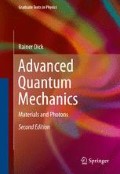Abstract
We will now start to quantize the Maxwell field \(A_{\mu }(x) =\{ -\Phi (x)/c,\boldsymbol{A}(x)\}\) similar to the quantization of the Schrödinger field. The fact that electromagnetism has a gauge invariance implies that there are more components than actual dynamical degrees of freedom in the Maxwell field. This will make quantization a little more challenging than for the Schrödinger field, but we will overcome those difficulties.
Access this chapter
Tax calculation will be finalised at checkout
Purchases are for personal use only
Notes
- 1.
R.J. Glauber, Phys. Rev. 131, 2766 (1963).
- 2.
Classically these equations would hold for time averages.
- 3.
Recall that densities of states \(\varrho (E) \sim k^{2}dk/dE\) in the \(V \rightarrow \infty\) limit have units of \(\mathrm{cm}^{-3}\mathrm{eV}^{-1}\), see the remark after equation (12.8).
- 4.
The result in box normalization is \(\boldsymbol{j}(\boldsymbol{k}) = (c/V )\hat{\boldsymbol{k}}\).
- 5.
An exception is positronium with m = m e ∕2.
- 6.
H.A. Kramers, W. Heisenberg, Z. Phys. 31, 681 (1925).
- 7.
The combination \(r_{e} \equiv \mu _{0}e^{2}/4\pi m = 2.82\,\mathrm{fm}\) is also denoted as the classical radius of the electron.
- 8.
A loophole in this argument concerns the remote possibility that all the matrix elements \(\langle n'',\zeta ''\vert \mathbf{x}\vert n,\zeta \rangle\) with \(\omega _{n'',n} \gtrsim ck\) are extremely small.
- 9.
V. Weisskopf, Annalen Phys. 401, 23 (1931). He used a dipole operator \(H = -e\boldsymbol{x} \cdot \dot{\boldsymbol{ A}}(\boldsymbol{x},t)\) for atom-photon interactions throughout his calculations.
Bibliography
J.D. Jackson, Classical Electrodynamics, 3rd edn. (Wiley, New York, 1999)
Author information
Authors and Affiliations
Rights and permissions
Copyright information
© 2016 Springer International Publishing Switzerland
About this chapter
Cite this chapter
Dick, R. (2016). Quantization of the Maxwell Field: Photons. In: Advanced Quantum Mechanics. Graduate Texts in Physics. Springer, Cham. https://doi.org/10.1007/978-3-319-25675-7_18
Download citation
DOI: https://doi.org/10.1007/978-3-319-25675-7_18
Published:
Publisher Name: Springer, Cham
Print ISBN: 978-3-319-25674-0
Online ISBN: 978-3-319-25675-7
eBook Packages: Physics and AstronomyPhysics and Astronomy (R0)

